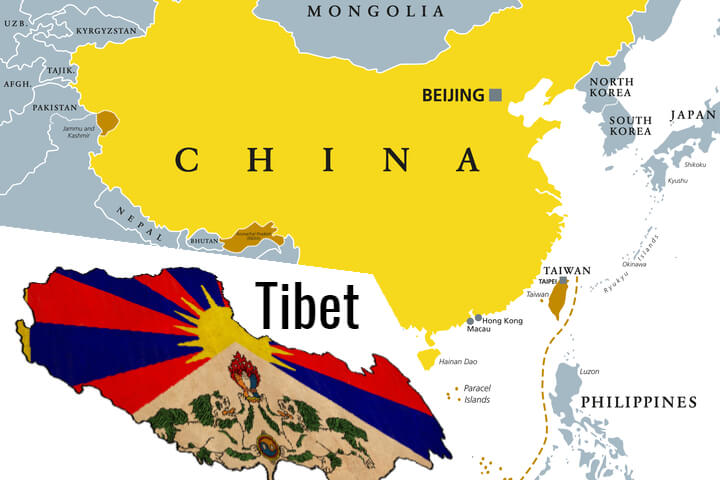Around 40 Tibetans have been released from among more than 1,000 people arrested by Chinese police for protesting a dam project that could submerge ancient monasteries in a Tibetan-populated township of southwestern China’s Sichuan province, sources from inside Tibet told Radio Free Asia.
Chinese authorities released about 20 monks each on Monday and Tuesday, said the sources who spoke on condition of anonymity for safety reasons.
They were among a large group of monks arrested from Wonto Monastery, the sources said. However, after their release, authorities imposed strict restrictions on their contact with the outside world, the sources added.
On Feb. 23, police arrested more than 1,000 Tibetans, including monks and residents, of Dege county in Sichuan’s Kardze Autonomous Tibetan Prefecture, who had been peacefully protesting the construction of the Gangtuo Dam.
If built, the structure could submerge monasteries in Dege’s Wangbuding township and force residents of at least two villages near the Drichu River to relocate, sources told RFA.
The fate of the monasteries on both sides of the Drichu, or Jinsha in Chinese, has been at the center of the protests staged since Feb. 14 by Buddhist monks and local Tibetans, who have expressed distress at the expected destruction of the centuries-old religious institutions, including Wonto Monastery, which dates back to the 13th century.
“One of the main reasons for the release of the Tibetans is the growing media coverage abroad of the mass arrests that have taken place,” one source told RFA.
Some of the arrested Tibetans were beaten during the interrogations and later had to be admitted to the hospital. They were also informed individually at the hospital that they would be allowed to return to the monasteries on Wednesday, the same source said.
But authorities forbade them to communicate with outsiders, the sources said.
After the arrest of a number of monks from Wonto on Feb. 22 and Feb. 23, authorities prohibited all religious activities within the monastery, a second source said.
Chinese police have also imposed strict restrictions on the movement of monks to and from the various monasteries located on both sides of the Drichu River, the same person said.
Monastery murals
Besides the Wonto Monastery, the Yena and Khardho monasteries in Wangbuding on the east bank of the Drichu River and the Rabten, Gonsar, Tashi and Pharok monasteries in the Tibetan Autonomous Region on the west bank of the river may be affected by the building of the dam.
At China’s 8th International Academic Symposium on Tibetan Archaeology and Art in Hangzhou in December 2023, postgraduate student Yao Ruiyi warned in a study that the hydropower station “will cause greater difficulties in the subsequent preservation and research of the Wangdui Temple murals,” using another name for the Wonto Monastery.
“Therefore, the research and protection of Wangdui Temple murals is urgent,” the study said.
Wonto Monastery, which dates back to the 13th century, would likely be flooded by the dam project on the Drichu River in Dege county, southwestern China’s Sichuan province. (Citizen journalist)
The Gangtuo Dam is part of a plan that China’s National Development and Reform Commission announced in 2012 to build a massive 13-tier hydropower complex on the Drichu. It would be located at Wontok (or Gangtuo, in Chinese) in Dege county, northwest of Kardze Tibetan Autonomous Prefecture. The total planned capacity of the 13 hydropower stations is 13,920 megawatts.
Foreign outcry
Representatives of the U.S. and Canadian governments as well as global rights groups and Tibetan advocacy groups have condemned China’s arrest of the 1,000 dam protesters, calling for the immediate release of those detained and for the preservation of the cultural, religious and linguistic identity of Tibetans.
In a post to the social media network X on Monday, the U.S. Congressional-Executive Commission on China condemned “the reported violent repression of peaceful protests against the planned destruction of 2 villages and 6 monasteries by a hydropower dam project,” referring to RFA’s report on the mass arrests.
“Those detained must be released and the PRC must protect the cultural heritage of Tibetan Buddhist monasteries,” the Commission said, referring to the People’s Republic of China.
A day earlier, Uzra Zeya, the U.S. under secretary for civilian security, democracy and human rights and U.S. special coordinator for Tibetan Issues, also posted a message to X noting that the centuries-old monasteries “are home to hundreds of Tibetan Buddhist monks and contain irreplaceable cultural relics.”
“The U.S. stands with Tibetans in preserving their unique cultural, religious, and linguistic identity,” she wrote.
RFA reported on Feb. 15 that at least 300 Tibetans gathered outside Dege County Town Hall to protest the building of the Gangtuo Dam.
Tibetans in exile have been holding mass demonstrations in various parts of the world, including Dharamsala, India – home to the exiled Tibetan spiritual leader, the Dalai Lama – and New York, Zurich and Toronto.

